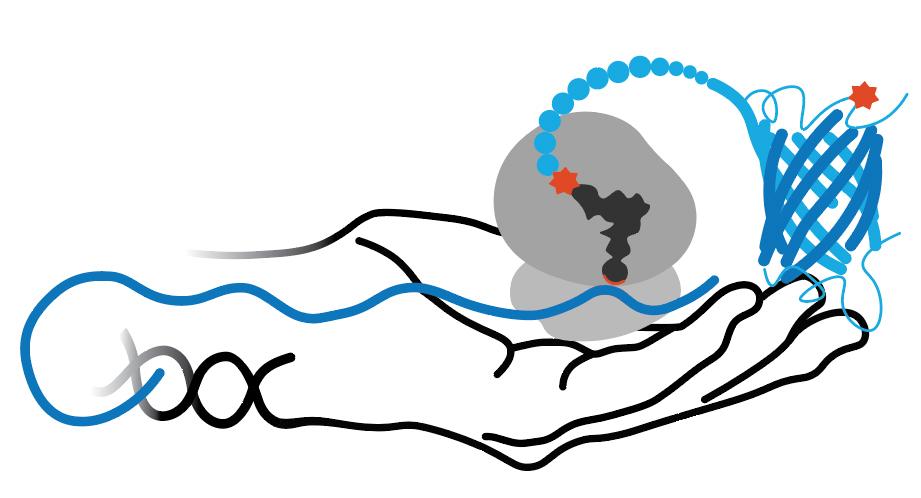RS/tRNA Foundational Publication Support
Hao, Ziyang, Yanqun Song, Shixian Lin, Maiyun Yang, Yujie Liang, Jing Wang, and Peng R Chen. (2011) 2011. “A Readily Synthesized Cyclic Pyrrolysine Analogue For Site-Specific Protein "Click" Labeling.”. Chemical Communications (Cambridge, England) 47 (15): 4502-4. doi:10.1039/c1cc00024a.
Li, Yiming, Maiyun Yang, Yichao Huang, Xiaoda Song, Lei Liu, and Peng R. Chen. (0BC) 2012. “Genetically Encoded Alkenyl–Pyrrolysine Analogues For Thiol–Ene Reaction Mediated Site-Specific Protein Labeling”. Chemical Science 3 (9): 2766-2770, . doi:10.1039/C2SC20433A.
RS/tRNA Usage Publications
Li, Yiming, Man Pan, Yitong Li, Yichao Huang, and Qingxiang Guo. (2013) 2013. “Thiol-Yne Radical Reaction Mediated Site-Specific Protein Labeling Via Genetic Incorporation Of An Alkynyl-L-Lysine Analogue.”. Organic & Biomolecular Chemistry 11 (16): 2624-9. doi:10.1039/c3ob27116a.
RS/tRNA Pair Development Year
2011
ncAA(s) Incorporated
N6-((2-azidoethoxy)carbonyl)-L-lysine
ncAA Structure (png, jpg, jpeg)
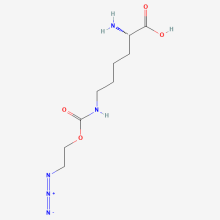
ncAA Utility
Reactive handle for azide-alkyne cycloaddition
N6-(((1R,2R)-2-azidocyclopentyloxy)carbonyl)-L-lysine (ACPK)
ncAA Structure (png, jpg, jpeg)
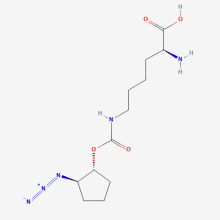
ncAA Utility
n/a
BlocLys
ncAA Structure (png, jpg, jpeg)
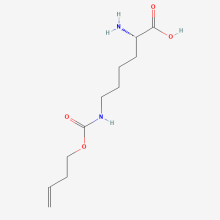
ncAA Utility
Reactive handle for thiol-ene reaction
PlocLys
ncAA Structure (png, jpg, jpeg)
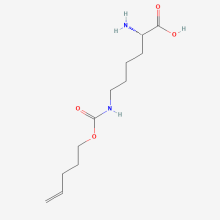
ncAA Utility
n/a
N6-((Pent-4-yn-1-yloxy)carbonyl)-L-lysine
ncAA Structure (png, jpg, jpeg)
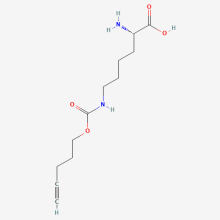
ncAA Utility
Reactive handle for thiol-yne reaction
RS Organism of Origin
Parent RS
RS Mutations
L274A
C313V
Y349F
C313V
Y349F
tRNA Organism of Origin
Parent tRNA
tRNA Anticodon
CUA
RS/tRNA Availability
N/A
RS/tRNA Additional Notes
In E.coli BL21-DE3 cells, produced GFP-N149-ACPK at ~10mg/L.
By incorporating ACPK handle into HdeA-V58, it was shown that a BTTES-assisted CuAAC can be used in tandem with the ACPK handle for protein click labeling in living bacterial cells.
Incorporated in mammalian Hek-293 cells at p53, ACPKRS successfully produced mutant protein p53EGFP-K372-ACPK, with green fluorescence only being observed by confocal-microscopy when cells were supplemented by 1mM ACPK. Incorporation of ACPK by ACPKRS was measured as 50% of wt at p53 by immunoblotting analysis.
By incorporating ACPK handle into HdeA-V58, it was shown that a BTTES-assisted CuAAC can be used in tandem with the ACPK handle for protein click labeling in living bacterial cells.
Incorporated in mammalian Hek-293 cells at p53, ACPKRS successfully produced mutant protein p53EGFP-K372-ACPK, with green fluorescence only being observed by confocal-microscopy when cells were supplemented by 1mM ACPK. Incorporation of ACPK by ACPKRS was measured as 50% of wt at p53 by immunoblotting analysis.
